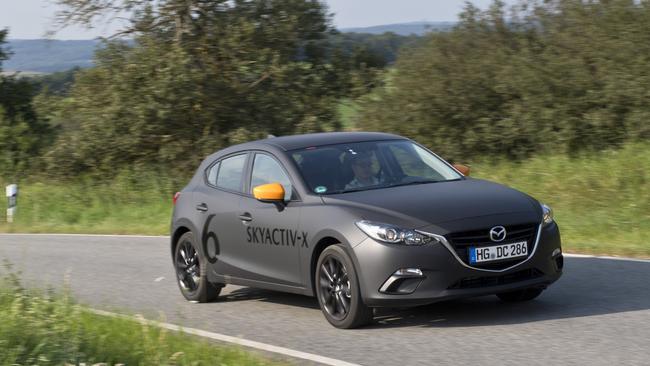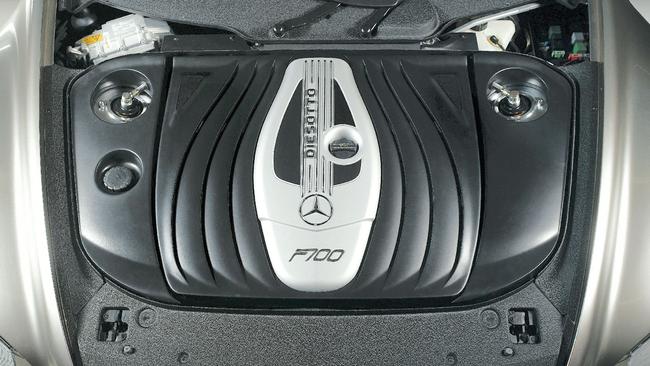Mazda engine breakthrough to prolong life of petrol cars
Mazda’s revolutionary engine will ensure that petrol-powered cars will survive for decades.

Mazda is about to win one of the most important races the car industry has seen in decades. The Japanese brand will launch a revolutionary engine in 2019, one that delivers low, diesel-like fuel consumption while running on clean-burning petrol.
Mazda’s new 2.0-litre four-cylinder will go into production to coincide with the next generation of the popular Mazda3. It will ensure that affordable and efficient internal combustion will be available for decades to come.
The engine uses a form of compression ignition, like a diesel, an innovative means of combustion developed entirely by the Hiroshima maker. Compared to today’s engines, it burns a weaker mix of petrol and air, yet power improves and carbon dioxide emissions are drastically cut.

Controlling a compression ignition petrol engine isn’t easy — make the mix too lean and the air-fuel mix can explode too quickly during acceleration and damage the engine.
Get it right, though, and there is a twofold pay-off — a big reduction in fuel consumption and lower pollution because petrol burns cleaner than diesel.
Mazda’s approach, though ingenious, is difficult. The breakthrough is creating a tiny ball of easily ignited fuel and air around the tip of the engine’s spark plug.
When set off by the spark plug, the fireball expands to compress the lean mixture filling the rest of the cylinder hard enough to make it also burn.
The engine also comes with a small supercharger — Mazda calls it an “air-supply device”, as its purpose is to push extra air into the cylinders to thin the fuel mixture, not boost power. Other additions are high-pressure fuel delivery and in-cylinder sensors.

Making the tech work wasn’t easy.
“I don’t think I would want to do it ever again,” says Mazda technical research boss Mitsuo Hitomi. The complexity of the task was daunting, the 63-year-old engineer reckons.
Ideas were evaluated using computer simulations and prototype engines.
With reliable combustion depending on the management of 11 parameters, finding what worked was needle-in-a-haystack hard.
“If you change each parameter five points, the combinations become 50 million points,” says Hitomi.
For an engine that is still two years from production, Mazda has clearly mastered the basics of the technology.

To back up a series of briefings in Frankfurt, the company brought prototype engines in current model Mazda3 hatchbacks with manual and automatic transmissions for test drives.
The engine is a beauty; smooth, quiet and, with 140kW on tap, really lively. The 2.0-litre pulls strongly at low and middling engine speeds, a little like a turbo diesel. But it spins easily to 6000rpm, like a petrol engine.
Data-logging equipment fitted to the cars recorded impressively low fuel consumption despite the test-drive loop consisting of slow-moving town traffic and unrestricted autobahn where keeping up with the Germans meant driving at more than 150km/h.
Traffic and speed are fuel efficiency killers but the automatic used a little over 6.0L/100km and the manual a little more. Compared to a Mazda3 with an already efficient engine, the real-world efficiency gains were in the 15 to 17 per cent range.
According to engineer Hitomi, the compression engine works even better with Australia’s 91 octane petrol than Europe’s 95 octane. He reckons the engine will be affordable, too, at a little below today’s turbo diesels but more than a current technology petrol engine.
LEAN FORWARD
For years, car makers have been trying to develop engines to run on weak mixtures of fuel and air — “lean” is the engineers’ term.
Other car makers, all much larger than Mazda, have tried in the past to develop such an engine. The best known is probably Mercedes-Benz’s Diesotto, which went public a decade ago as a prototype show car. General Motors built some engine prototypes about the same time and Honda was working on the idea as long ago as the mid-’90s. None succeeded.
Mazda brought working prototypes of the engine to the Frankfurt briefings.
The coming 2.0-litre packs about 20kW more punch than the engine now used in the popular Mazda3 and, Mazda claims, will deliver real-world fuel consumption about 20 per cent lower than the current engine.
Mazda believes that improving the efficiency of the internal combustion engine is the best way to reduce the amount of carbon dioxide, a major greenhouse gas, emitted by cars.
The company is working on a battery-powered car that it plans to launch in EV-friendly markets from 2019. It also believes internal combustion engines will still be needed for the vast majority of cars over the next 20 years. Many will be hybrid or plug-in hybrids — which will require internal combustion engines.

What’s more, an internal combustion engine with much improved efficiency can do more to cut CO2 emissions than switching to an electric vehicle in countries where electricity is generated by burning fossil fuels.
Mazda’s data indicate its new-tech engine can emit less CO2 than a typical EV running on electricity from a power station burning coal, oil or natural gas.
Technical research boss Hitomi believes the new Mazda engines will play a role in restoring consumer confidence.
“We must regain customer trust, both due to Dieselgate and fuel economy scandals,” he says, even though Mazda has not been embroiled in the latest emissions cheating controversy.
Nor does he regard maintaining urban air quality as a barrier to further development.
“There is a move to eliminate vehicles with internal combustion engines in some cities,” Hitomi says. “In Japan we also have a big city, Tokyo. There are lots of vehicles.” In his view,
“We don’t have any serious air pollution problem. So I believe we can coexist with the internal combustion engine, even in the big cities.”

TIGHT AS A DRUM
Mazda’s new engine is part of a suite of next-generation technologies it has developed. One of them is a solution to a long-time Mazda weakness — excessive road noise.
The next-gen Mazda3, due in 2019, will have tiny noise-killers built into the body structure, promises vehicle development executive Hiroyuki Matsumoto.
A number of small and carefully placed brackets topped by resin pads will bridge gaps inside hollow parts of the body, such as the door pillars. They work the same way as a drummer silencing a cymbal with nothing more than a fingertip touch.



